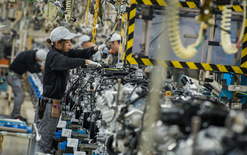Light trucks tested for safety

Four top-selling light trucks have been examined by ANCAP for the first time as part of an initiative to boost safety standards, and help business operators and private buyers make “informed decisions”.
While light trucks are increasing in popularity, some experts believe advancements in safety features and technologies in this segment have yet to kept pace with other vehicle classes.
Light trucks, along with other goods vehicles such as commercial vans and medium and heavy trucks, remain over-represented in fatal and serious-injury collisions in Australia, adds ANCAP.
It says these vehicles make up less than three per cent of all registered vehicles on Australia’s roads, yet they are involved in around 15 per cent of all fatal crashes.
To combat this, ANCAP’s light truck ADAS safety comparison, which was launched in mid-May, seeks to bring greater accountability and standards to the segment through a new assessment regime. The aim is to identify a baseline level of safety performance.
It says light trucks represent an important segment of the market, often being responsible for the “last mile” of delivery to people’s homes and as the transport of choice for many small to medium businesses. Compared to other segments, they offer carrying capacity at a relatively affordable price point with the ability to be driven on a car licence.
These factors, and the growing scale of online shopping and delivery demand since the Covid-19 pandemic, have led to increased sales.
Carla Hoorweg, ANCAP’s chief executive officer, says: “When it comes to road safety, the human cost of doing nothing is too great to ignore.
“We call on the entire industry to embrace this as an opportunity to prioritise improving features in their vehicles and recognise the positive role they can play in making roads safer.
“Each of the truck models examined bring their individual merits and all have complied with the Australian government’s regulatory safety requirements ahead of their mandating.
Yet, in comparison to other segments and consumer expectations, there’s still a fair way to go.
“It’s not just about having the technology on board. We want to understand how well it works and where there can be areas of improvement.
“Through this programme, we are aiming to drive positive change among the truck industry, fleet operators and small-business owners. From these inaugural findings, we expect to see safety performance improve quite quickly through voluntary updates introduced by manufacturers.”
Light-truck models tested
Australia’s three top-selling light trucks, the Isuzu N-Series, Fuso Canter and Hino 300 Series – and its highest-selling battery-electric light truck, Foton’s T5 – were selected for examination.
The model ranges of these four vehicles account for 74 per cent of all new light-duty trucks sold across the Tasman in 2024 – or 10,788 units.
They were assessed at the Transport for NSW’s future mobility testing and research centre – a National Association of Testing Authorities (NATA) accredited laboratory. Their performances were examined against criteria and procedures refined with input from manufacturers and industry representatives.
Each was purchased independently on the retail market, and tested to the same standards and processes to ensure a fair, accurate and independent safety assessment.
ANCAP says buying these vehicles from dealerships is essential it ensures those being tested are the same as a buyer would get and drive.
The features examined included the fitment and performance of low and high-speed autonomous emergency braking, lane-support systems, speed-assistance systems and occupant detection. Airbag and seatbelt fitment was also examined, with all four trucks lacking these features for the centre passenger’s position.
Considering the potential weight of goods being transported, assessments were undertaken with each truck laden to 50 per cent of its carrying capacity. Extra tests were carried out with differing load conditions to examine any variance in performance.
Findings from the comparison show that advanced safety technologies are available for, and can be fitted into, light trucks. But current-generation systems are limited in functionality.
With new and updated models expected to be introduced by manufacturers soon, ANCAP says the opportunity exists for manufacturers to go beyond regulatory basics and provide customers with the best products possible. Safety improvements are expected in new generations set for late 2025 and beyond.
The findings from this comparison have been used to determine baseline performance benchmarks with performance gradings to be introduced from 2026. Full details can be found in the light truck ADAS safety comparison report online at www.ancap.com.au/light-trucks.





